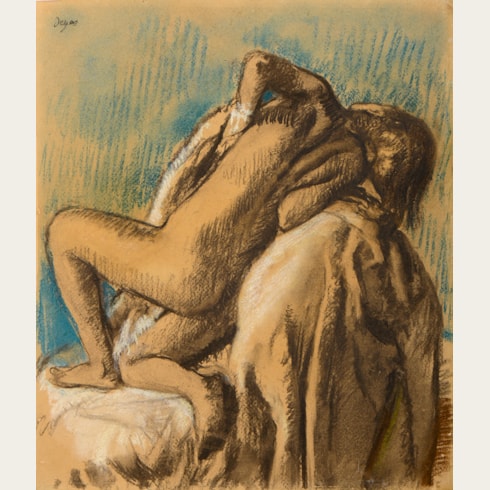Edgar DEGAS
(Paris 1834 - Paris 1917)
Landscape with a Path Leading to a Copse of Trees
Signed and dedicated à M. Charpentier / Degas at the lower right.
271 x 358 mm. (10 5/8 x 14 in.) [sheet]
The present sheet is one of a group of some three dozen pastel-worked monotype landscapes executed by Degas between 1890 and 18922. It was in October 1890, while staying at the home of the painter and printmaker Georges Jeanniot in the village of Diénay, near Dijon in Burgundy, that Degas began to produce a new series of colour monotype landscapes, many enriched with pastel. Although he had first made pastellized monotypes a decade or so earlier, the ones produced at Diénay, and in the months following, were in a larger format, and were more technically audacious. Degas worked on the plates using diluted oil paint, creating effects by rubbing the medium with cloths or brushes, sometimes using the end of a brush handle or his finger to create lines or other forms.
This landscape was included in Paul-André Lemoisne’s catalogue of Degas’ oeuvre, but with no dimensions given, which suggests that he may not have seen it in person. It is also described by Lemoisne as being in pastel alone, an understandable error as the composition has been so thoroughly reworked in pastel by the artist that the monotype base is hardly evident. Indeed, as Theodore Reff has recently noted of the present sheet, ‘Only parts of the trees and perhaps of the sky seem to remain of the monotype impression, although the intermittently sharp edges of the plate mark along the sides and bottom may also be vestiges of that impression. The surface was then extensively reworked in pastel, applied both in a liquid form (Degas is known to have steamed chalk strokes to liquefy them and then to have reworked them with a brush) and in a dry form once the previous layers had dried.’
This is one of two landscapes executed in pastel over monotype presented by the artist to the publisher and collector Georges Charpentier (1846-1905). The other pastel, similarly signed and dedicated, and of identical dimensions, is a Landscape by the Edge of the Sea, today in the collection of the Musée des Beaux-Arts in Neuchâtel in Switzerland. Like the present sheet, it passed from Charpentier to the dealer Ambroise Vollard (1866-1939).
Provenance
Literature
Exhibition


















